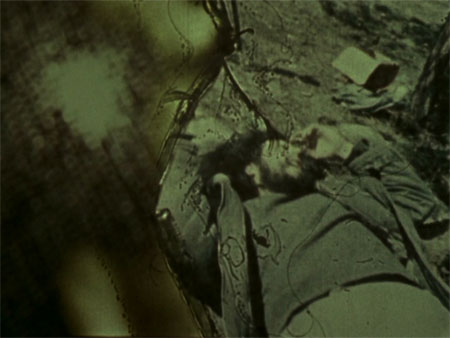THIS POST CONTAINS A PICTURE OF AN EVISCERATED CORPSE, IF YOU DON’T WANT TO SEE IT, DON’T READ THIS POST.
A part of this viewing list: Criterion Collection Spine #184: Stanley Brakhage’s By Brakhage: an anthology.

I’d forgotten how good Stan Brakhage is at the avant-garde filmmaking gig. It has been 5 years since my brief obsession with avant-garde film; I should really get back into it. There is a lot of talk [linked below] about relational spectatorship, subjectivity, deconstruction and any number of other theories that attempt to parse out what Brakhage was trying to do with his numerous films. This collection of 26 works by Brakhage, and knowing a bit about the man from the supplementary commentary on the discs, leads me to believe that the fundamental goal of a Brakhage film is to be devoid of all subjectivity and objectivity; something merely exists to be shown. His paint-films seem to approximate synaesthesia, and while I can see some merit in the assertions that Brakhage wants his viewers to see light, I think there is a more general goal here; Brakhage wants us to see things that we take for granted, or never see in the first place. I like the man more than his films, which is saying a lot. He seemed like a man with a good heart and an earnestness about him that completely threw away any pretention. He wasn’t doing avant-garde stuff to be edgy, but because it suited him.

So watching a film like The Act of Seeing With One’s Own Eyes, that shows graphic visions of autopsies, is a chance to see a dead body before it is all maked-up for viewing. Sure we hear about death and dead bodies all the time and see them on TV, but how often do we actually get to see a dead body without all the fuss we put around it. The only thing that could be closer than this film is to actually go to a morgue. Dog Star Man is his earliest masterpiece, and is the visual representation of man’s place in the universe with a bit of our ultimate futility thrown in for good measure. This is the least happy of his films, in my opinion. Tons of footage of Brakhage running up a snowy mountain carrying an axe. Tough work, two forward one back, his determination becomes admirable, but his final failure hurts just as badly. Window Water Baby Moving is an amazing document of the birth of his first child, and I was rooting on Jane Brakhage and then baby Myrrena through the whole thing. It is quite graphic too, but like his autopsy film, how often does the average person get the chance to witness a birth?

The older he got, the more refined and experimental he became. The collaged detritus of Mothlight is beautiful, and it looks as if it were made of the stuff that you pull out of the ceiling lamp shade. The Wold Shadow is a horror film, or at least ridiculously creepy, and consists of shot of a woodland over various times and has Brakhage painting or tweaking the plate or the film in such a way that it looks as if there is something moving in the wood. He says it is his homage to the God in the Wood, and it certainly should be. Much of the rest consists of paint on film, each individual frame painted by Brakhage and many of them could be considered great abstract art; when they’re animated and modified, the effect is wholly engrossing. This is what synapse firing would look like. The Dante Quartet is probably the most easily accessible of the paint-films, and Black Ice the most evocative. There is a later film with his grandchildren that is statelier and more meditative, it seems more about analyzing time than light. All in all, this anthology was extremely enjoyable, and although I wouldn’t recommend watching the autopsy film over breakfast [as I did], of all the films that he made, that one affected me the most. We miss you, Stan.

- Criterion Essay by Fred Camper
- Fred Camper’s Brakhage site
- Senses of Cinema on Brakhage
- Interview: Brakhage at Sixty
- Criterion Collection collection of links to essays on Brakhage
- Stan Brakhage on Ubu
- YouTube Madness
- The Dante Quartet
- Dog Star Man, Part 2
- Desistfilm
- The Garden of Earthly Delights
- Delicacies of Molten Horror Synapse
- Black Ice
- Rage Net